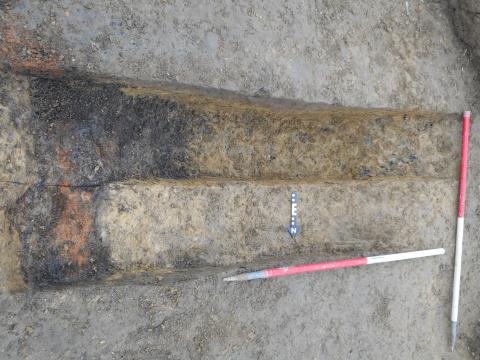In March 2016 further excavation took place in Charlwood. A trench (T3) was located across a magnetometry anomaly which appeared to be associated with the 'burnt bone' ditch revealed in 2014 (Bull 449). It had been decided that the 2014 feature needed some clarification to determine what the ditch might be related to, having been dated by both pottery analysis and C14 dating to the transition period of the Late Iron Age and early Roman Britain. Three test pits were also placed across magnetometry anomalies in the field to enable future plans for the project to be considered.
Test pits:
Test pits 1 and 2 were set over anomalies near the northern field edge. TP1 was devoid of any features and TP2 revealed a layer of stone metalling interpreted as a path laid down to assist passage across the clay from field to field. Test Pit 3 was sited over a large magnetic anomaly and this proved to be a heavily burnt area at a depth of 25cm. It was decided to investigate this further and TP3 became Trench 4. An area of 4mx3m was opened and a linear formed by heavy burning  extending beyound the baulks both east and west was uncovered. A section across this revealed a burnt clay edge which suggested a post medieval date. This has been tentatively interpreted as the base of a possible charcoal burning clamp.
extending beyound the baulks both east and west was uncovered. A section across this revealed a burnt clay edge which suggested a post medieval date. This has been tentatively interpreted as the base of a possible charcoal burning clamp.
Trench 3:
This 8mx3m trench was sited c3m north of the 2014 trench. Much of the area was devoid of features but a further ditch was uncovered on a similar alignment to the 2014 ditch. This new ditch (303) was not full of cremated material though flecks of charcoal and bone were present as well as a small quantity of potsherds of similar LIA/ERB date to those found in 2014. As in 2014 the features are consistently found at c25cm below the land surface at the bottom of the ploughsoil and have been truncated.
Extensions to T3 to investigate other magnetic anomalies revealed nothing and an area over the 2014 trench was opened to confirm the relationship with ditch 303. It was also decided to cut some test pits on the probably eastern line of these ditches to see if they continued across the field. This proved that they were running east for at least a further 10m
It has become clear that magnetometry in the heavy clay geology of this area does not pick up the ditches that have been found. Further work will be based on using the location of the 2104 and 2016 trenches to extend excavation across the field both east and west. It is hoped that excavation in 2017 will begin to answer the question as to the extent of these ditches and their purpose.
Grateful thanks goes to all those who volunteered to help on this site and persevered in spite of the often unpleasant conditions.


